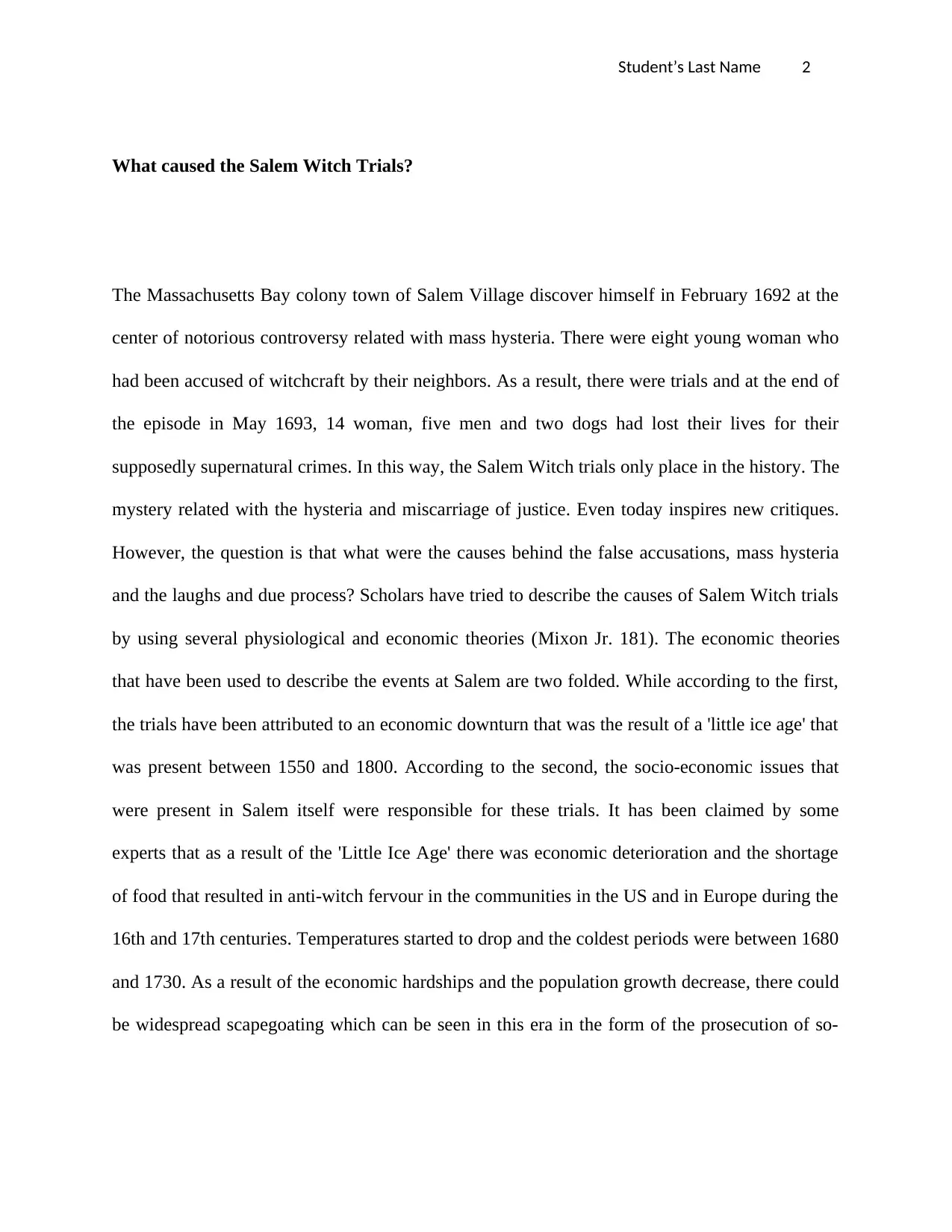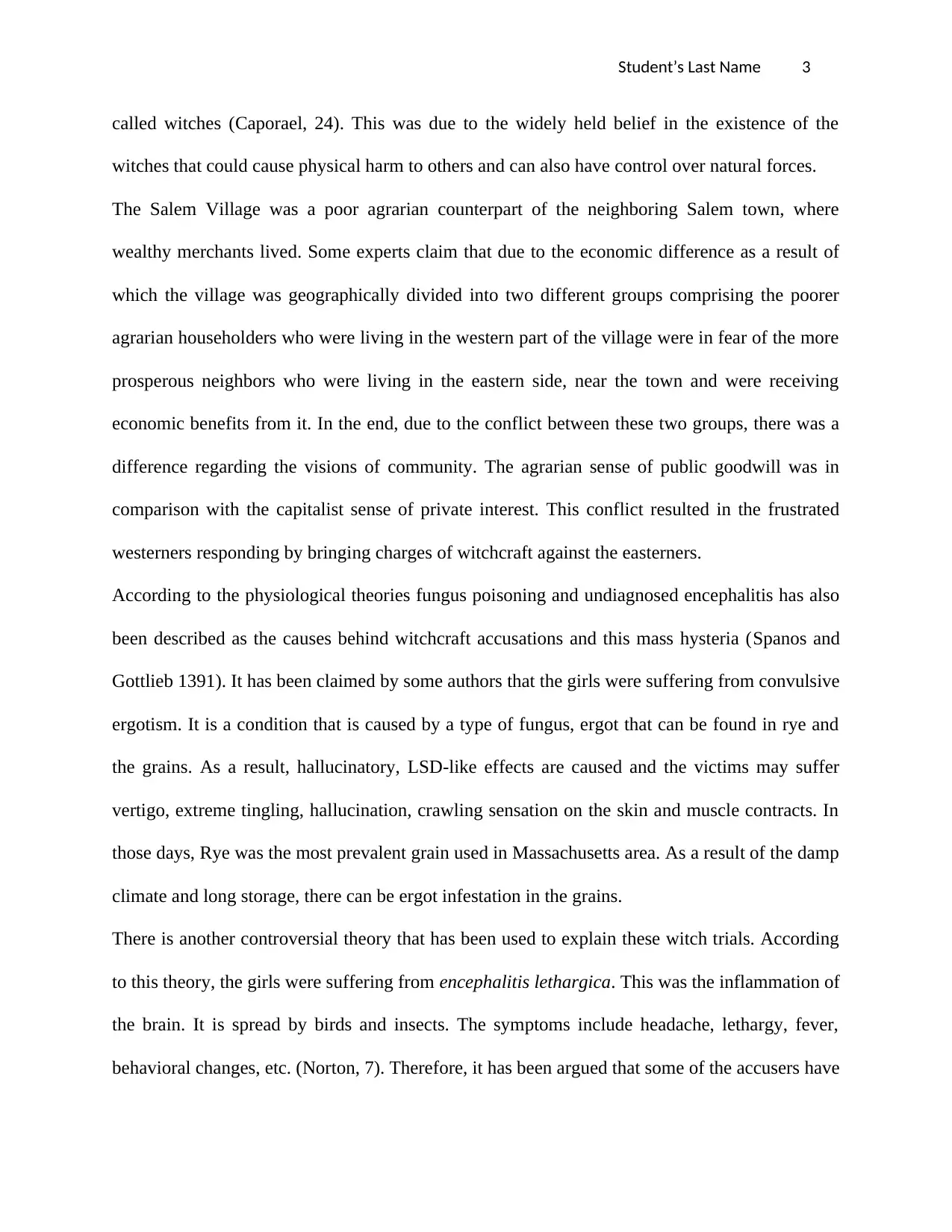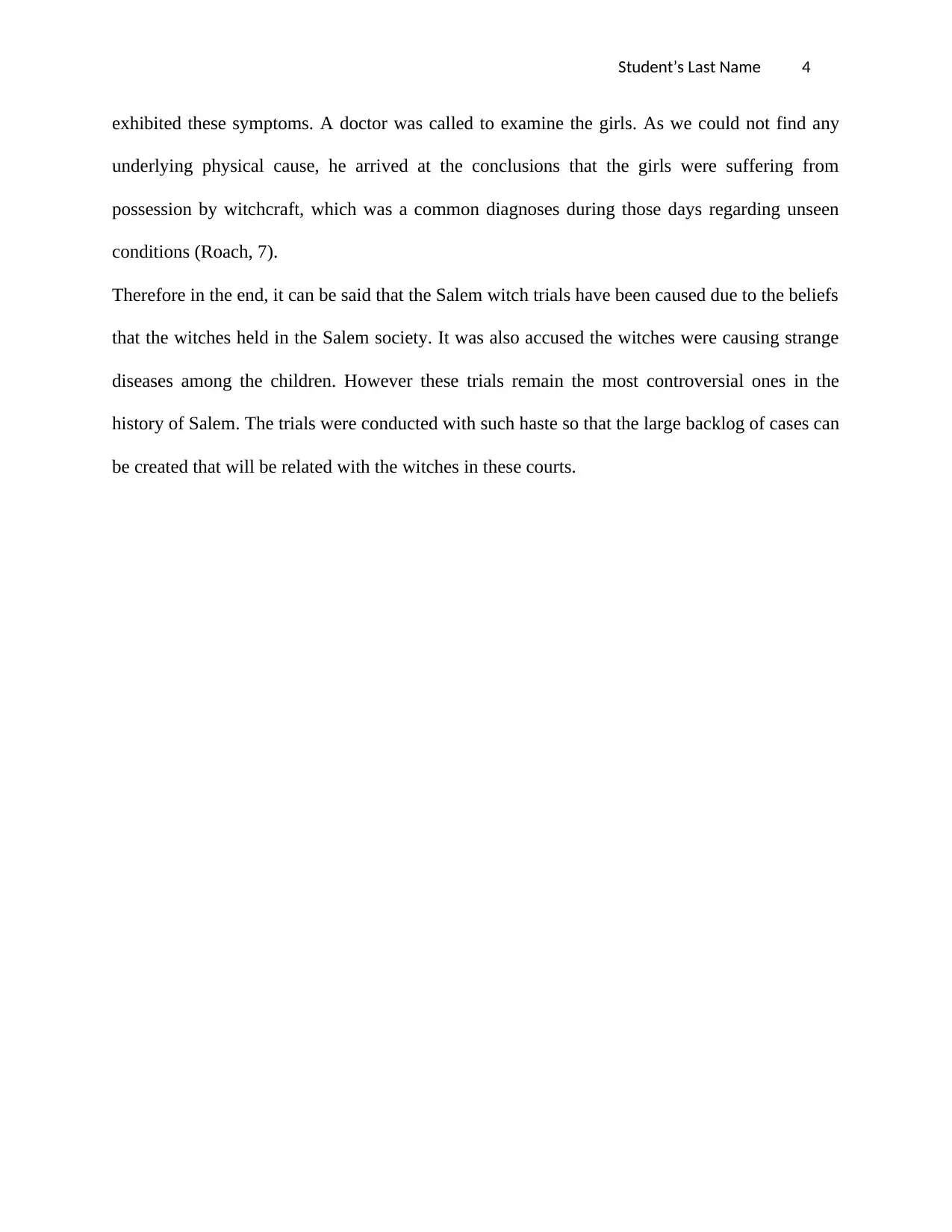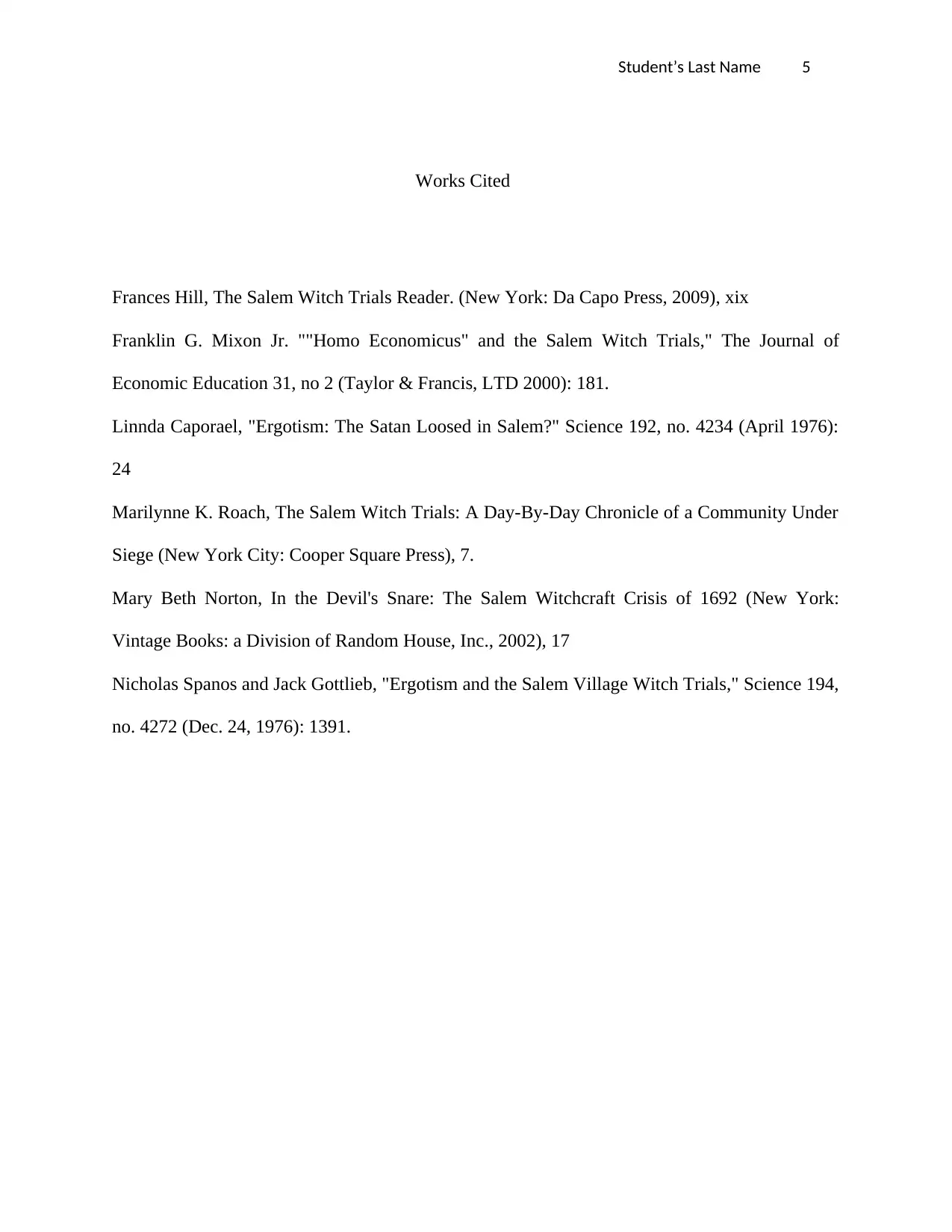A Deep Dive: Exploring the Causes Behind the Salem Witch Trials
VerifiedAdded on 2020/02/19
|5
|1052
|29
Essay
AI Summary
This essay examines the multifaceted causes of the Salem Witch Trials of 1692 in Salem Village, Massachusetts. It delves into the historical context, highlighting the mass hysteria and miscarriage of justice that characterized the event. The essay explores both economic and physiological theories, including the impact of the 'Little Ice Age' and socio-economic disparities within Salem Village. It also discusses physiological explanations such as ergotism and encephalitis, which may have contributed to the accusations and symptoms exhibited by the accusers. The essay references scholarly works to provide a comprehensive analysis of the factors that led to the trials and the tragic loss of life, ultimately emphasizing the complex interplay of beliefs, societal pressures, and potential medical conditions that fueled this dark chapter in history.

Student’s Last Name 1
First and Last name
Professor’s name
Class
Date
First and Last name
Professor’s name
Class
Date
Paraphrase This Document
Need a fresh take? Get an instant paraphrase of this document with our AI Paraphraser

Student’s Last Name 2
What caused the Salem Witch Trials?
The Massachusetts Bay colony town of Salem Village discover himself in February 1692 at the
center of notorious controversy related with mass hysteria. There were eight young woman who
had been accused of witchcraft by their neighbors. As a result, there were trials and at the end of
the episode in May 1693, 14 woman, five men and two dogs had lost their lives for their
supposedly supernatural crimes. In this way, the Salem Witch trials only place in the history. The
mystery related with the hysteria and miscarriage of justice. Even today inspires new critiques.
However, the question is that what were the causes behind the false accusations, mass hysteria
and the laughs and due process? Scholars have tried to describe the causes of Salem Witch trials
by using several physiological and economic theories (Mixon Jr. 181). The economic theories
that have been used to describe the events at Salem are two folded. While according to the first,
the trials have been attributed to an economic downturn that was the result of a 'little ice age' that
was present between 1550 and 1800. According to the second, the socio-economic issues that
were present in Salem itself were responsible for these trials. It has been claimed by some
experts that as a result of the 'Little Ice Age' there was economic deterioration and the shortage
of food that resulted in anti-witch fervour in the communities in the US and in Europe during the
16th and 17th centuries. Temperatures started to drop and the coldest periods were between 1680
and 1730. As a result of the economic hardships and the population growth decrease, there could
be widespread scapegoating which can be seen in this era in the form of the prosecution of so-
What caused the Salem Witch Trials?
The Massachusetts Bay colony town of Salem Village discover himself in February 1692 at the
center of notorious controversy related with mass hysteria. There were eight young woman who
had been accused of witchcraft by their neighbors. As a result, there were trials and at the end of
the episode in May 1693, 14 woman, five men and two dogs had lost their lives for their
supposedly supernatural crimes. In this way, the Salem Witch trials only place in the history. The
mystery related with the hysteria and miscarriage of justice. Even today inspires new critiques.
However, the question is that what were the causes behind the false accusations, mass hysteria
and the laughs and due process? Scholars have tried to describe the causes of Salem Witch trials
by using several physiological and economic theories (Mixon Jr. 181). The economic theories
that have been used to describe the events at Salem are two folded. While according to the first,
the trials have been attributed to an economic downturn that was the result of a 'little ice age' that
was present between 1550 and 1800. According to the second, the socio-economic issues that
were present in Salem itself were responsible for these trials. It has been claimed by some
experts that as a result of the 'Little Ice Age' there was economic deterioration and the shortage
of food that resulted in anti-witch fervour in the communities in the US and in Europe during the
16th and 17th centuries. Temperatures started to drop and the coldest periods were between 1680
and 1730. As a result of the economic hardships and the population growth decrease, there could
be widespread scapegoating which can be seen in this era in the form of the prosecution of so-

Student’s Last Name 3
called witches (Caporael, 24). This was due to the widely held belief in the existence of the
witches that could cause physical harm to others and can also have control over natural forces.
The Salem Village was a poor agrarian counterpart of the neighboring Salem town, where
wealthy merchants lived. Some experts claim that due to the economic difference as a result of
which the village was geographically divided into two different groups comprising the poorer
agrarian householders who were living in the western part of the village were in fear of the more
prosperous neighbors who were living in the eastern side, near the town and were receiving
economic benefits from it. In the end, due to the conflict between these two groups, there was a
difference regarding the visions of community. The agrarian sense of public goodwill was in
comparison with the capitalist sense of private interest. This conflict resulted in the frustrated
westerners responding by bringing charges of witchcraft against the easterners.
According to the physiological theories fungus poisoning and undiagnosed encephalitis has also
been described as the causes behind witchcraft accusations and this mass hysteria (Spanos and
Gottlieb 1391). It has been claimed by some authors that the girls were suffering from convulsive
ergotism. It is a condition that is caused by a type of fungus, ergot that can be found in rye and
the grains. As a result, hallucinatory, LSD-like effects are caused and the victims may suffer
vertigo, extreme tingling, hallucination, crawling sensation on the skin and muscle contracts. In
those days, Rye was the most prevalent grain used in Massachusetts area. As a result of the damp
climate and long storage, there can be ergot infestation in the grains.
There is another controversial theory that has been used to explain these witch trials. According
to this theory, the girls were suffering from encephalitis lethargica. This was the inflammation of
the brain. It is spread by birds and insects. The symptoms include headache, lethargy, fever,
behavioral changes, etc. (Norton, 7). Therefore, it has been argued that some of the accusers have
called witches (Caporael, 24). This was due to the widely held belief in the existence of the
witches that could cause physical harm to others and can also have control over natural forces.
The Salem Village was a poor agrarian counterpart of the neighboring Salem town, where
wealthy merchants lived. Some experts claim that due to the economic difference as a result of
which the village was geographically divided into two different groups comprising the poorer
agrarian householders who were living in the western part of the village were in fear of the more
prosperous neighbors who were living in the eastern side, near the town and were receiving
economic benefits from it. In the end, due to the conflict between these two groups, there was a
difference regarding the visions of community. The agrarian sense of public goodwill was in
comparison with the capitalist sense of private interest. This conflict resulted in the frustrated
westerners responding by bringing charges of witchcraft against the easterners.
According to the physiological theories fungus poisoning and undiagnosed encephalitis has also
been described as the causes behind witchcraft accusations and this mass hysteria (Spanos and
Gottlieb 1391). It has been claimed by some authors that the girls were suffering from convulsive
ergotism. It is a condition that is caused by a type of fungus, ergot that can be found in rye and
the grains. As a result, hallucinatory, LSD-like effects are caused and the victims may suffer
vertigo, extreme tingling, hallucination, crawling sensation on the skin and muscle contracts. In
those days, Rye was the most prevalent grain used in Massachusetts area. As a result of the damp
climate and long storage, there can be ergot infestation in the grains.
There is another controversial theory that has been used to explain these witch trials. According
to this theory, the girls were suffering from encephalitis lethargica. This was the inflammation of
the brain. It is spread by birds and insects. The symptoms include headache, lethargy, fever,
behavioral changes, etc. (Norton, 7). Therefore, it has been argued that some of the accusers have
⊘ This is a preview!⊘
Do you want full access?
Subscribe today to unlock all pages.

Trusted by 1+ million students worldwide

Student’s Last Name 4
exhibited these symptoms. A doctor was called to examine the girls. As we could not find any
underlying physical cause, he arrived at the conclusions that the girls were suffering from
possession by witchcraft, which was a common diagnoses during those days regarding unseen
conditions (Roach, 7).
Therefore in the end, it can be said that the Salem witch trials have been caused due to the beliefs
that the witches held in the Salem society. It was also accused the witches were causing strange
diseases among the children. However these trials remain the most controversial ones in the
history of Salem. The trials were conducted with such haste so that the large backlog of cases can
be created that will be related with the witches in these courts.
exhibited these symptoms. A doctor was called to examine the girls. As we could not find any
underlying physical cause, he arrived at the conclusions that the girls were suffering from
possession by witchcraft, which was a common diagnoses during those days regarding unseen
conditions (Roach, 7).
Therefore in the end, it can be said that the Salem witch trials have been caused due to the beliefs
that the witches held in the Salem society. It was also accused the witches were causing strange
diseases among the children. However these trials remain the most controversial ones in the
history of Salem. The trials were conducted with such haste so that the large backlog of cases can
be created that will be related with the witches in these courts.
Paraphrase This Document
Need a fresh take? Get an instant paraphrase of this document with our AI Paraphraser

Student’s Last Name 5
Works Cited
Frances Hill, The Salem Witch Trials Reader. (New York: Da Capo Press, 2009), xix
Franklin G. Mixon Jr. ""Homo Economicus" and the Salem Witch Trials," The Journal of
Economic Education 31, no 2 (Taylor & Francis, LTD 2000): 181.
Linnda Caporael, "Ergotism: The Satan Loosed in Salem?" Science 192, no. 4234 (April 1976):
24
Marilynne K. Roach, The Salem Witch Trials: A Day-By-Day Chronicle of a Community Under
Siege (New York City: Cooper Square Press), 7.
Mary Beth Norton, In the Devil's Snare: The Salem Witchcraft Crisis of 1692 (New York:
Vintage Books: a Division of Random House, Inc., 2002), 17
Nicholas Spanos and Jack Gottlieb, "Ergotism and the Salem Village Witch Trials," Science 194,
no. 4272 (Dec. 24, 1976): 1391.
Works Cited
Frances Hill, The Salem Witch Trials Reader. (New York: Da Capo Press, 2009), xix
Franklin G. Mixon Jr. ""Homo Economicus" and the Salem Witch Trials," The Journal of
Economic Education 31, no 2 (Taylor & Francis, LTD 2000): 181.
Linnda Caporael, "Ergotism: The Satan Loosed in Salem?" Science 192, no. 4234 (April 1976):
24
Marilynne K. Roach, The Salem Witch Trials: A Day-By-Day Chronicle of a Community Under
Siege (New York City: Cooper Square Press), 7.
Mary Beth Norton, In the Devil's Snare: The Salem Witchcraft Crisis of 1692 (New York:
Vintage Books: a Division of Random House, Inc., 2002), 17
Nicholas Spanos and Jack Gottlieb, "Ergotism and the Salem Village Witch Trials," Science 194,
no. 4272 (Dec. 24, 1976): 1391.
1 out of 5
Your All-in-One AI-Powered Toolkit for Academic Success.
+13062052269
info@desklib.com
Available 24*7 on WhatsApp / Email
![[object Object]](/_next/static/media/star-bottom.7253800d.svg)
Unlock your academic potential
Copyright © 2020–2025 A2Z Services. All Rights Reserved. Developed and managed by ZUCOL.
